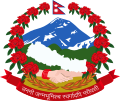Search results
Appearance
There is a page named "Ethnolinguistics" on Wikipedia
- Ethnolinguistics (sometimes called cultural linguistics) is an area of anthropological linguistics that studies the relationship between a language and...12 KB (1,416 words) - 17:13, 23 May 2024
- Ethnolinguistic Groups of the Cordilleras)the Cordilleran peoples, are an ethnic group composed of nine main ethnolinguistic groups whose domains are in the Cordillera Mountain Range, altogether...43 KB (4,658 words) - 18:18, 14 June 2024recognises 135 distinct ethnic groups. There are at least 108 different ethnolinguistic groups in Myanmar, consisting mainly of distinct Tibeto-Burman peoples...269 KB (23,859 words) - 15:46, 29 June 2024alongside Bengali. Bangladesh forms the sovereign part of the historic and ethnolinguistic region of Bengal, which was divided during the Partition of India in...336 KB (29,718 words) - 08:50, 2 July 2024Online Person-centered Salvage Transidioethnography Video Ethnohistory Ethnolinguistics Ethnology Ethnomathematics Ethnostatistics Ethnomedicine Ethnomethodology...164 KB (17,067 words) - 07:28, 16 June 2024Pacific Islander (section Ethnolinguistics)Several hundred distinct languages are spoken in the Pacific Islands. In ethnolinguistic terms, the Pacific islanders of Oceania are divided into two different...53 KB (5,598 words) - 12:12, 24 June 2024was a linguist who made contributions to the philosophy of language, ethnolinguistics, and to the theory and practice of education. He made a major contribution...31 KB (3,363 words) - 18:20, 1 July 2024Cushitic-speaking peoples are the ethnolinguistic groups who speak Cushitic languages natively. Today, Cushitic languages are spoken primarily in the...5 KB (555 words) - 20:45, 3 June 2024The Butuanon are an ethnolinguistic group who inhabited in the region of Caraga. They are part of the wider ethnolinguistic group Bisaya people, who constitute...3 KB (169 words) - 19:39, 14 June 2024Ethnolinguistic Groups of Mainland Southeast Asia...132 KB (12,322 words) - 17:58, 25 June 2024Валентина Т. (1998). Alfred F. Majewicz, International Institute of Ethnolinguistics and Oriental Studies (IIEOS) (ed.). Кялундзюги-Симонова Словарь удэгейского...4 KB (331 words) - 14:33, 15 March 2024Ethnolinguistic map comprising the territories of Austria-Hungary (1910), with German-speaking areas shown in red...139 KB (13,953 words) - 17:04, 1 July 2024official language and serves as lingua franca among Nepali of different ethnolinguistic groups. The regional languages Maithili, Awadhi and Bhojpuri are spoken...268 KB (23,887 words) - 13:11, 2 July 2024country range from 75 to 85, and in 2017, the country's three largest ethnolinguistic groups were the Punjabis (making up 38.8% of the total population)...353 KB (33,274 words) - 00:37, 3 July 2024
- Online Person-centered Salvage Transidioethnography Video Ethnohistory Ethnolinguistics Ethnology Ethnomathematics Ethnostatistics Ethnomedicine Ethnomethodology...63 KB (2,049 words) - 16:26, 14 June 2024
- + linguistics English Wikipedia has an article on: ethnolinguistics Wikipedia ethnolinguistics (uncountable) The field of linguistic anthropology which
- Filipinos come from various Austronesian ethnolinguistic groups. Currently, there are more than 175 ethnolinguistic groups, each with its own language, identity
- influenced the indigenous languages and cultures to a certain degree. (i) Ethnolinguistic regions – refer to certain geographical areas where particular groups
- South America, in particular lowland tropical South America. As an "ethnolinguistic field guide," this book is a hybrid between an etymological dictionary














